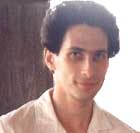Contents: 2024 | 2023 | 2022 | 2021 | 2020 | 2019 | 2018 | 2017 | 2016 | 2015 | 2014 | 2013 | 2012 | 2011 | 2010 | 2009 | 2008 | 2007 | 2006 | 2005 | 2004 | 2003 | 2002 | 2001
2004, 15
Diffraction errors at sound intensity measurement
language: Russian
received 23.09.2004, published 25.10.2004
Download article (PDF, 220 kb, ZIP), use browser command "Save Target As..."
To read this document you need Adobe Acrobat © Reader software, which is simple to use and available at no cost. Use version 4.0 or higher. You can download software from Adobe site (http://www.adobe.com/).
ABSTRACT
The known systematic errors caused by finite-difference approximation and a divergence of phase characteristics of receivers’ channels are inherent in a sound intensity measurement method by means of two microphones. Mutual influence of receivers owing to diffraction effects results in occurrence of new type of systematic errors. Diffraction can influence to a result of sound intensity measurement by two ways: by means of distortion of a pressure field of an incident wave by its dispersion on the other receiver included in a pair and by means of influence of change of acoustic resistance of receivers on their sensitivity.
The error because of distortion of sensitivity of microphones increases at the small wave sizes of distance between transducers and decreases when the distance between microphones increases. The error owing to diffraction distortions of the pressure is taken into account together with an error of finite-difference approximation. This error increases with growth of wave distance between transducers. These two effects limit a frequency range of intensity measurements at low and high frequencies. Relative reduction of microphone sizes results in shift of intensimeter working range to higher frequencies.
The obtained dependencies of diffraction errors of intensity measurement allow to choose a working range of the wave sizes of a distance between microphones. The relation between measured and true intensities allows to take into account the distortion of measured values, induced by the device, during processing of measurement results.
10 pages, 2 figures
Сitation: I. L. Sheinman. Diffraction errors at sound intensity measurement. Electronic Journal “Technical Acoustics”, http://www.ejta.org, 2004, 15.
REFERENCES
1. Колесников А. Е. Акустические измерения. Л.: Судостроение, 1983.
2. Intensity measurements. The analysis technique of the nineties. Bruel & Kjaer. Naerum, 1988.
3. Янг С., Эллисон А. Измерение шума машин. Пер. с англ. М.: Энергоатомиздат, 1988.
4. Tompson J. K., Tree D. R. Finite difference approximation errors in acoustic intensity measurements. J. Sound and Vibration. 1981. V. 75. № 2. 229–238.
5. Chung I. Y. Cross-spectral method of measuring acoustic intensity without error caused by instrument phase mismatch. JASA. 1978. V. 64. № 6. 1613–1616.
6. Шейнман И. Л. Погрешности измерения интенсивности звука, вызываемые взаимным влиянием используемых приемников. Известия ГЭТУ. 1993. № 456.
38–41.
7. Шейнман И. Л. Погрешности измерения интенсивности звука в воде, вызываемые взаимным влиянием используемых приемников. Техническая акустика. 1995. Т. 4. № 3–4. 50–53.
8. Акустика в задачах. Учеб. рук-во для Вузов. под ред. Гурбатова С. Н. и Руденко О. В. М.: Наука, Физматлит, 1996.
9. Тюрин А. М. Теоретическая акустика. Л. 1971
10. Смарышев М. Д., Добровольский Ю. Ю. Гидроакустические антенны. Справочник. Л.: Судостроение, 1984.
11. Лепендин Л. Ф. Акустика. Учеб. Пособие для втузов. М.: Высш. Школа, 1978.
12. Шейнман И. Л., Ильин Д. В. Особенности влияния дифракции при измерении интенсивности звука в воде. Материалы международной конференции «Гидроакустика 2002». С-Петербург, 2002.
 |
Ilya Sheinman graduated from Saint-Petersburg State Electrical Engineering University (Department of Electroacoustics and Ultrasonic Equipment, 1993) and Saint-Petersburg State University (Department of Mathematics and Computer Science, 1996). Ph.D. (in radio-physics) from Saint-Petersburg State Electrical Engineering University, 1997. Presently he is assistant professor at this University (Department of Physics). Scientific areas: electrodynamics of moving environments, particle accelerator physics, plasma physics, acoustic measurements, theoretical acoustics. e-mail: isheinman(at)yandex.ru |
